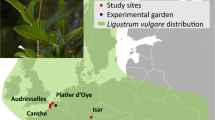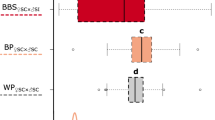Summary
Self incompatibility was investigated in the hexaploid garden chrysanthemum, a member of Compositae. Nine sibling clones selected from a highly compatible cross were all self incompatible. 14.8% of the crosses between these sibs in diallel were compatible, but one sib, 67-111-42, accounted for 10 of the 12 compatible crosses. 67-111-42 was also more compatible than the remaining 8 sibs in crosses to other closely related plants. Crosses of the 9 sibs to 12 unrelated tester clones indicated that none were male or female sterile. Inbreeding via pseudocompatibility was successful in increasing homozygosity at the S loci. The percentage of compatible crosses obtained in 3 sib diallels of I 2 clones from crosses of 67-111-42I 1 plants approached that of the original 9 × 9 diallel, but no one individual accounted for most of the compatible crosses. It was possible to separate the 9 sibs into 9 incompatibility patterns from the pollinations made in this study. The evidence suggests that the self-incompatibility reaction in the garden chrysanthemum is sporophytic and involves more than 1 locus.
Similar content being viewed by others
Literature
Bateman, A. P.: Self-incompatibility systems in angiosperms. III. Cruciferae. Heredity 9, 53–68 (1955).
Brewbaker, J. L.: Incompatibility in auto-tetraploid white clover. II. Dominance and double reduction. Genetics 40, 137–152 (1955).
Brewer, J. G., Parlevliet, J. E.: Incompatibility as a new method for identification of pyrethrum clones. Euphytica 18, 320–325 (1969).
Crowe, L. K.: Incompatibility in Cosmos bipinnatus. Heredity 8, 1–11 (1954).
Dowrick, G. J.: The chromosomes of chrysanthemum. II. Garden varieties. Heredity 7, 59–72 (1953).
Fryxell, P. A.: Mode of reproduction of higher plants. Bot. Rev. 23, 135–233 (1957).
Gerstel, D. U.: Self-incompatibility studies in guayule. II. Inheritance. Genetics 35, 482–506 (1950).
Habura, E. Ch.: ParaSterilität bei Sonnenblumen. Z. Pflanzenzücht. 37, 280–298 (1957).
Hughes, M. B., Babcock, E. B.: Self incompatibility in Crepis foetida (L) subspecies roeadifotia (Biel) Schiz et Keller. Genetics 35, 570–588 (1950).
Imrie, B. C., Knowles, P. F.: Genetic studies of self-incompatibility in Carthamus flavescens Spreng. Crop Sci. 11, 6–9 (1971).
Lewis, D.: Comparative incompatibility in angiosperms and fungi. Adv. Genet. 6, 235–285 (1954).
Lundqvist, A.: Self-incompatibility in Dactylis glomerata L. Hereditas (Lund) 61, 353–360 (1969).
Martin, F. W.: The system of self-incompatibility in Ipomoea. J. Hered. 59, 263–267 (1968).
Mulford, F. L.: Results of selfing twenty-four early blooming chrysanthemums. Proc. Amer. Soc. Hort. Sci. 35, 818–821 (1937).
Author information
Authors and Affiliations
Additional information
Communicated by H. F. Linskens
Scientific Journal Series Paper Number 7882 of the Minnesota Agricultural Experiment Station.
Lyndon W. Drewlow was a National Science Foundation Trainee.
Rights and permissions
About this article
Cite this article
Drewlow, L.W., Ascher, P.D. & Widmer, R.E. Genetic studies of self incompatibility in the garden chrysanthemum, Chrysanthemum morifolium ramat. Theoret. Appl. Genetics 43, 1–5 (1973). https://doi.org/10.1007/BF00277824
Received:
Issue Date:
DOI: https://doi.org/10.1007/BF00277824




